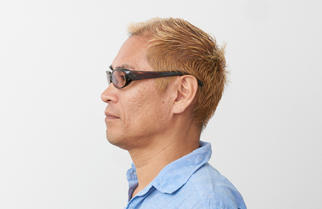
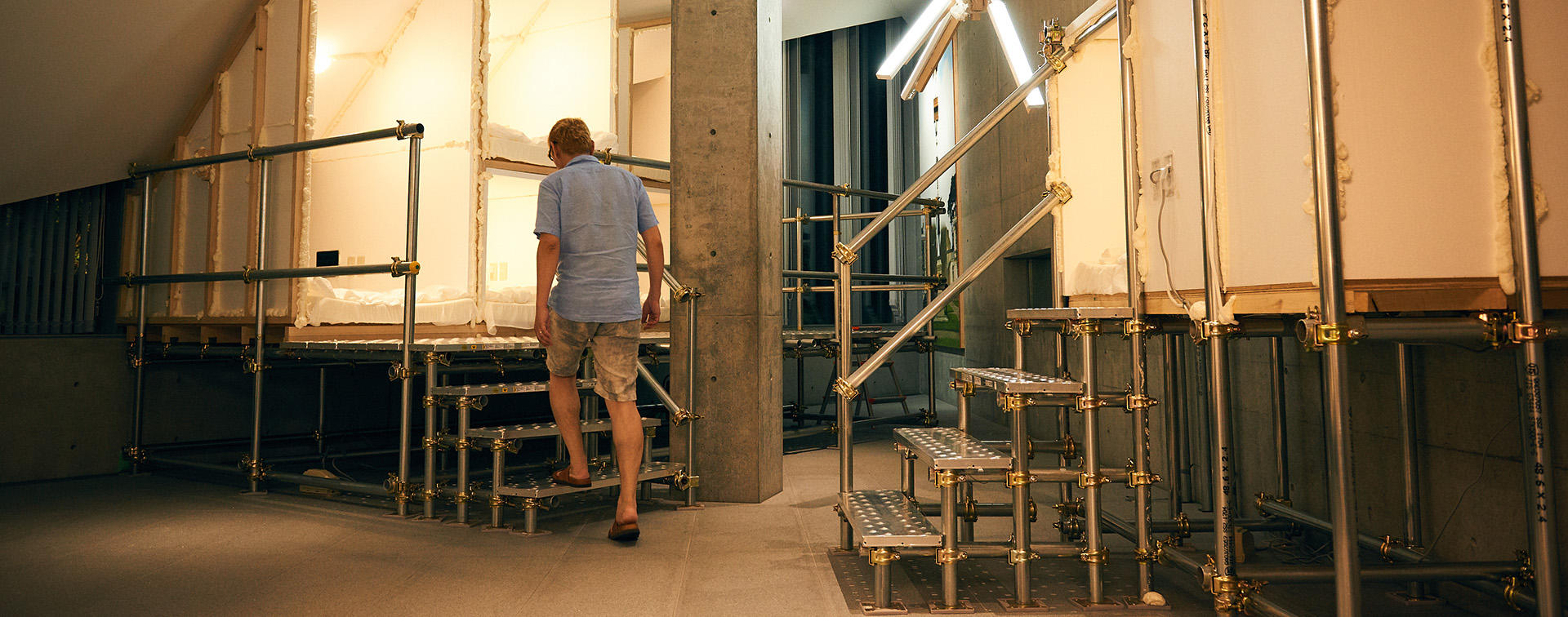
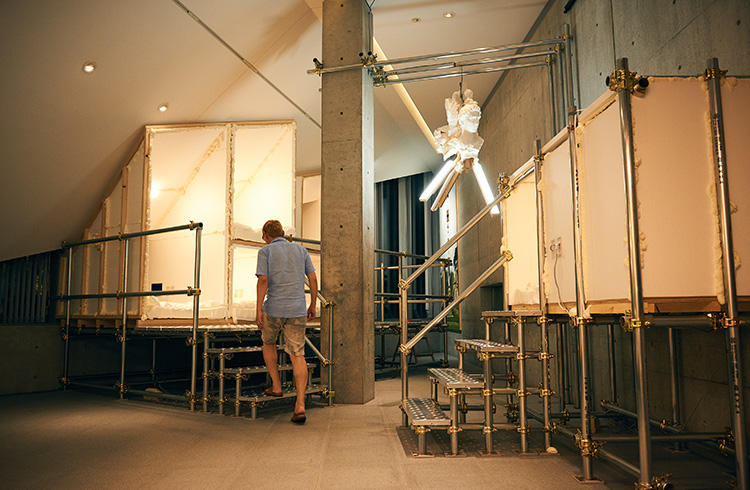
What big projects offer to people and city
A taxi runnning on subway lines, a bedroom in the cemetery Tatzu Nishi turns things in a city into suprising bold art
Mr. Tatzu Nishi changes symbolic monuments such as the Statue of Columbus in New York and the Merlion in Singapore, and public things or spaces such as street lights and chimneys into private spaces, such as a hotel room or a living room. His bold and unexpected installations have been amazing people all over the world. We interviewed Mr. Nishi, who has taken part in many "big projects," that defy your common sense, about what he wants to create in Roppongi and the meaning of what big projects offer to the city and the people.
Just by walking, you can feel the success of their urban planning.
I have been staying in Roppongi for a while to prepare for the exhibition, "GRAND PROJECTS: HOW FAR WILLYOU GO?" at 21_21 DESIGN SIGHT, and I see a lot of developments in this area. Especially between the Roppongi crossing and Nogizaka, there are Tokyo Midtown and the National Art Center, Tokyo now and the streets are cleaner bringing a lot nicer atmosphere to the area.

Exhibition "Grand Projects: HOW FAR WILL YOU GO?"
The exhibition showcases Grand Projects by such creators who give shape to their bold and innovative ideas that transcend existing modes of expressions. The process of meticulous planning and giving shape to a project while receiving the cooperation and support of many people, together with the finished works that are displayed on a huge scale, evoke a feeling of awe among the visitors who are likely to wonder, "How far will you go?"
Date:June 23 (Fri) - October 1 (Sun), 2017 / Closed Tuesdays
Place:21_21 DESIGN SIGHT
http://www.2121designsight.jp/program/grand_projects/
On the slanted street between Roppongi station and the National Art Center, Tokyo there are Blue Bottle Coffee and fashionable cafes as such but it was just an ordinary, plain street before (laughing). When you walkabout the area, you can see the urban planning going well. Take the benches along the street in Tokyo Midtown, they are so beautifully designed, you can see how much care was taken to create them.
On the other hand, I don't feel like my impression of Roppongi Crossing has changed. The view there has not changed much since I was a student at Musashino Art University; it's crowded and messy, has a Kabukicho feeling, like Salary-men (white-color workers) drinking till dawn and vomiting (laughing).
Come to think of it, there was a famous bar in Nishi-Azabu I have been once. Also, my girlfriend back in collage worked in Mamiana-zaka so, I wandered off down to Roppongi sometimes. My image of Roppongi was, and still is, the hippest, trendiest city in Japan. Even the people walking there reek of culture.
The act of thinking is beautiful. That is why I like human-made nature.
For me, the best place I want to live in Japan is this very area. Somewhere I can walk to Midtown. In the Midtown Garden, a human-made stream flows and the forcefully planted trees grow (laughing). I love this "artificial nature."
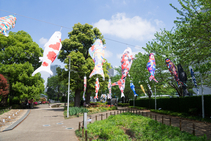
Midtown Garden
This"Art Gallery of Nature" is made of some 140 trees transplanted from the site of the former Self Defense Agency. To realize the concept of Tokyo Midtown "On the Green", AECOM of San Francisco designed the garden by taking ideas from traditional Japanese gardens.
To tell you the truth, I do not like the real nature. The only nature I like is the one completely tamed by man (laughter). Of course, I understand the beauty and the necessity of nature, but it bores me. When you see Bonsai, a Shakkei (borrowed landscape), or Japanese gardens, you can tell that Japanese people do not like real nature inherently.
I prefer "human-made" over real nature. You know how artists and designers think desperately of one thing or another through months and years of trial and error about their work, right? Even if the work was not successful, I think the act of thinking itself is beautiful.
An unconventional capsule-hotel sprung from a little chat
21_21 DESIGN SIGHT is one of my favorite works of Mr. Tadao Ando's architecture, and my installation "Capsule Hotel 21" that is on exhibit at this beautiful building right now, sprung when I had a little chat with Ms. Naoko Aono, the director of this exhibition, and Ms. Asako Saito, the program manager of 21_21 DESIGN SIGHT. We were exchanging ideas on the things we could do looking at the gallery when a collection of 3 feet wide windows which characterize the building, grabbed my attention. As a window was just about the width of a single bed, I said "it could be interesting if we turn this place to a capsule hotel." The ladies jumped into the idea immediately and within three minutes the direction of the installation was decided. That feeling of "That sounds good, let's do it!" seems to have carried us through until the end.
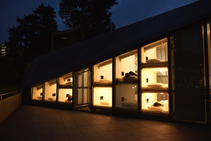
Capsule Hotel 21
Mr. Nishi's installation in the exhibition, "GRAND PROJECTS: HOW FAR WILLYOU GO?" at 21_21 DESIGN SIGHT(23 June - 1 October 2017)turned Gallery 3, which just opened on 31 March 2017, into a capsule hotel, utilizing the gallery's structure. Tadao Ando's architecture has been transformed into a space that is "99 percent impossible to create." There are events to experience the shower rooms and beds after the gallery closed for the night.
Create "Unusual Situation" and make it perform as art
During the creation of' Capsule Hotel 21', I came across many problems. I really thought about giving it up a few times (laughing). One big problem was how to complete the project within the budget. So, I came up with the idea of doing the complete opposite of Tadao Ando's simple and disciplined architecture and still make it perform as a form of art.
Therefore, the idea of reconstructing an ordinary capsule hotel was turned down right away. To meet the budget, I decided to create the surface of the capsule hotel out of polystyrene and polyurethane, which I had used in my works before. Those materials are usually hidden inside the walls in architecture but I tried to create a contrast with the perfection of Ando's architecture by putting the inside materials out.
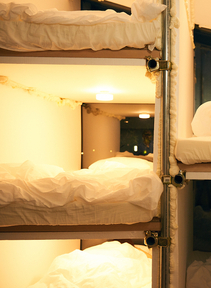
Styrene Foam, Urethane Foam, Pipe Scaffolding
The framework of the capsule hotel or the handrails for the stairs are made with pipe scaffolding; the walls of bed spaces polystyrene and polyurethane. The exquisite "bare" feel produces otherworldliness in a good way in Tadao Ando's architecture.
Another material I often use in my work is pipe scaffolding. Usually they are destined to be removed once construction is completed but the contradiction of using the materials that are supposed to be removed creates tension. As the dissonance with Ando's architecture increases, the more the building becomes part of my installation and the scale of my work becomes larger.
In terms of contradiction, "A capsule hotel in Tadao Ando Architecture" itself is a contradiction in the first place. "Capsule hotel with windows" and "Capsule hotel in the park's greenery" are also contradictions. Just like my previous projects, "improbable situations" were created here as well.

Attract the attention of the passers-by who are not interested in art.
Because I started out as an artist for an audience that is not related to art, I found this exhibition at 21_21 interesting although it is an exhibition facility. Since 21_21 is a design institution, the main audience is expected to be design related people and people in the architecture who are enticed by its creator Tadao Ando. Nonetheless, many regular shoppers and tourists may also come by as it is located in Tokyo Midtown. I believe the idea of "capsule hotel" worked for both types of audience. Most foreign tourists who come to Tokyo Midtown might have been taking a nap in those beds (laughing).
I had the intention of dragging shoppers and tourists into this building from the beginning. Gallery 3, which was never used for an exhibition before, has the exhibition room on the ground floor unlike the other exhibition space in 21_21 and I had also been thinking of making the best possible use of that advantage. "Capsule Hotel 21" was planned to make people who are not really into art say, "What the heck is this?!" and draw them in. Original chandelier and photography works that you can glimpse from the outside are also taking part in it. Besides all that, don't you think it will catch your attention if you see someone sleeping through the huge glass windows of the gallery (laughing)?
A taxi suddenly running through the subway between trains?!
This time the project is inside a building, but I wonder what I could do if I can do a big project in Roppongi outdoors. When I am asked to do a project by a city or an exhibition, I will stay in the city for about five days and walk around the area. I start getting the ideas as I learn about the streets, the atmosphere, the food, and the people in the area.
I never really saw Roppongi as a place for an exhibition until now... but talking just off the top of my head, how about a project using the subway? There are subway lines in Roppongi. I have been imagining the idea of running a taxi on subway lines for a while now. Replace the car tires with the subway train wheels and make the taxi run between train schedule.
It would certainly surprise people on the platform waiting for a train, "What? Why a taxi!?" (laughter). It would be a lot more fun if you could hail the taxi, but that is probably "100% impossible". Like that, I would love to get into the everyday lives of the people who are not interested in art.
A hotel you can spend a night with the dead celebrities
If I do the hotel project that I have been doing in other places in the world in Roppongi, what can I do...? Japan does not have many monuments compared to other countries, in the first place. Perhaps, you may think of Hachi the Loyal Dog in Shibuya and Saigo-don in Ueno, but that is about it.
Maybe I can use a cemetery instead of monuments. This is another idea I have been cherishing; building a bedroom around a grave of a famous person. I got the idea from the grave of Van Gogh in Auvers sur Oise, who had a longing for Japan. A project to put a bed beside Van Gogh's grave and build a hotel you can stay. You can spend a night with Van Gogh.
If I do it in Japan, I will make a Japanese room and put a futon (Japanese sleeping mattress) in front of the vertical grave sticking out from tatami mat. I would love to do it if there is a cemetery with a famous person's grave in Roppongi,
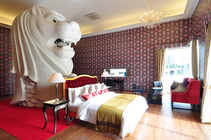
Hotel Project
Mr. Nishi's "Hotel Project" builds a private space such as a hotel or a living room around symbolic monuments, etc. One of the projects is "The Merlion Hotel" in "Singapore Biennale 2011" (photo). It took 2 months to build a luxurious hotel around the Merlion. His extraordinary idea became a topic of conversation and helped spread Mr. Nishi's name further in the world. The hotel was actually run that only one group could stay per night, and the reservations for the 2 month period booked solid in one hour.

Big projects need "ideas that attract people"
To me a "big project" naturally means a big scale, big budget exhibition. As I said before, I went outdoors because I wanted to show my work to the people who are not particularly interested in art, so the simple scale itself is rather important to me.
Take "Floating Piers, Lake Iseo, Italy, 2014-16" by Christo and Jeanne-Claude which is in the exhibition, "GRAND PROJECTS: HOW FAR WILL YOU GO?" as an example. The sheer scale of it provokes people's interest, making even those people who are not really into art feel 'I might as well go...'. No one can deny that big projects make more people interested in art.
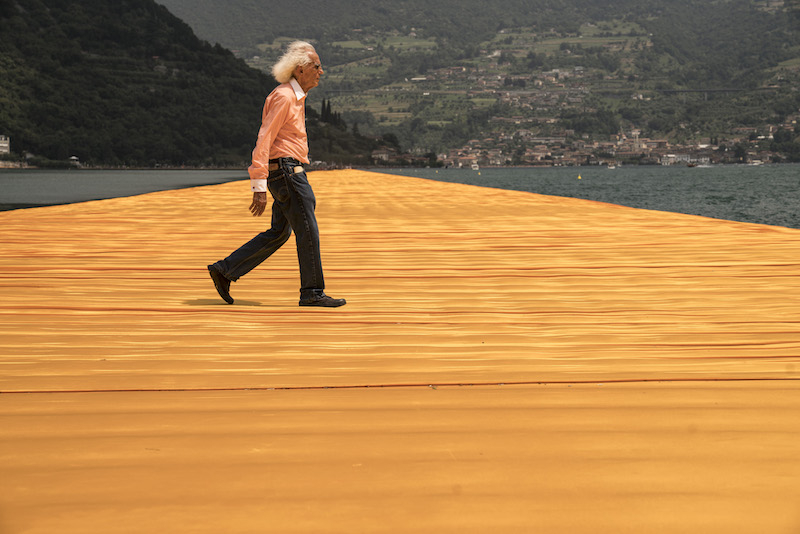
Floating Piers, Lake Iseo, Italy, 2014-16
This installation by Christo and Jeanne-Claude is in the exhibition, "GRAND PROJECTS: HOW FAR WILL YOU GO?" at 21_21 DESIGN SIGHT(23 June - 1 October, 2017)right now. When they first exhibited it at Lake Iseo in Italy, they created a 3-kilometer long pier made of cloth, and they covered the nearby sidewalks with the same cloth too. This sunshine-yellow world made with 100,000 square meter cloth elated all visitors.
(Photo:Wolfgang Volz)
That is why I started making my works outside. I used to show my works in museums and galleries too, but the audience was so little. When I did an exhibition in Cologne, Germany, there were so few people that I started to wonder "what am I doing this for?" I had been wondering about the reason for existence of art since I was in school, but this experience set my direction. It is necessary to have an environment where everyone can easily appreciate art. To set the direction of your life, you can only use your own imagination. Likewise, to set the direction of humankind, humans need to use all the imagination they have. That means imagination is essential to live as an individual just as much as we need it as the whole humankind. Perhaps no one would doubt that art have a role of expanding people's imagination and therefore, art should be accessible to everyone. That's why when I think of ideas, I try to sneak a trick that will trigger the people who are not art-oriented.
We should avoid losing good ideas because of tight restrictions.
Nowadays, there are a lot of large-scale biennales and exhibitions all over the world. They are increasing in Japan too, but with a few exceptions like Setouchi, I feel like most of them remain within the art scene. I always say, "Please just keep on doing even if it gets downsized."
At first local people look at us like "who are these strange people who come and exhibit strange things" (laughing). But, if you continue doing it, even people who are not art-oriented will automatically be exposed to artists and art works which should lead them to feel "contemporary art is interesting" in no time.
My projects have gotten some opposition campaigns from citizens and the media more than a few times. However, every time, without exception, the ones who were against my work become my supporters after the project opening. That is the interesting part.
There's just a problem doing huge exhibitions outside. I have been doing exhibitions in Japan for about a decade now, but it is extremely restricted to put up artwork in public spaces in Japan. Before I started doing it in Japan, I had thought Britain is really strict, but that was nothing compared to Japan (laughing). It is probably 10 times more restricted in Japan. If I had not gone to Germany and stayed in Japan instead, and came up with kind of the art works I exhibit now, I probably couldn't have realized them because of all the regulations in Japan. Now I come to think of it, going to Germany was the right choice for me.
There must be a lot of Japanese artists, designers, architects, or young students who have exciting ideas. But some must have given up on them because of the administrative regulations. That means we are losing those exciting ideas before they are realized. What a waste. People will come to where new things are born and that would also be meaningful financially, but Japan is going against the tide of the world.
Putting money in art will revitalize the city.
I am sorry if I sound so negative, but I have to say that Japan is putting too little money in art. There is a city called Nantes, that always ranks very high among the cities you would like to live in in France, and they put 15% of the city budget into art. It is the highest percentage in the world, and a lot of artists and tourists flock to this city. They started a classical music festival called "La Folle Journee" which has spread all over the world, including Tokyo, Kanazawa and Niigata, making Nantes an internationally potent city. Nantes also supports the world-famous giant marionette street theatre companies, La Machine and Royal de Luxe, both project bases are provided in the city.
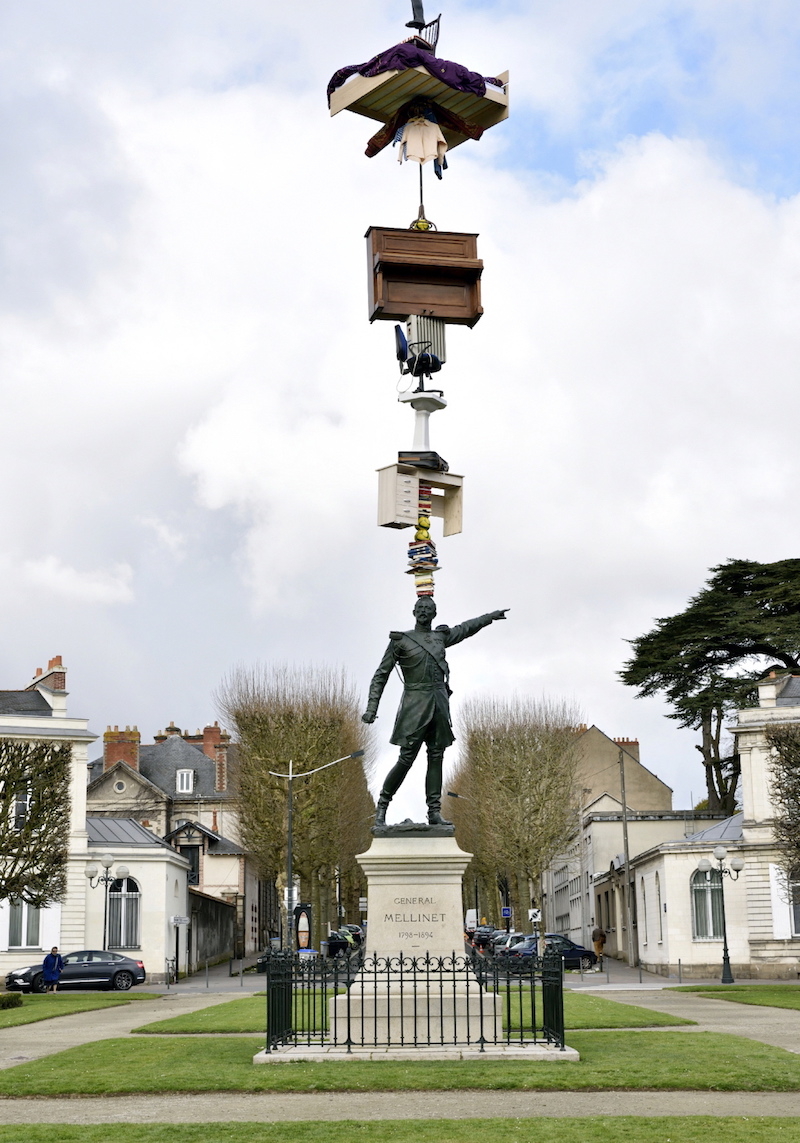
Nantes, France
Nantes is located in western France with beautiful townscape and a lot of art, contemporary and conventional. There are many art festivals and art events that attract people from all over the world. Mr. Nishi partook in the biennale "Estuaire 2009", an art event "Voyage a Nantes" in 2015 (photo) and had a one-man exhibition at HAB Galerie.
On the other hand, I believe Tokyo has put much less than 1 percent of its budget into art. I would not hope for 15 percent as that is an incredibly high percentage, but if they put at least 1 percent, it would nicely revitalize Tokyo and Roppongi with art.
The sad thing is, it is not only the government, but Japanese companies and wealthy people are also putting little money in art. About 5 years ago, a Dutch museum thought up a plan for an exhibition to introduce Japanese culture. They thought Japanese companies that have office there would co-sponsor and asked for support but not one company complied. The curator was very upset saying "I cannot not believe it!" (laughing). I totally understand how the curator felt. A museum in a foreign country is going out their way to plan an exhibition about your country and it is impossible to think that not your country nor companies from your country are contributing.
When I did the project "Discovering Columbus" in the US a couple of years ago, it was American companies and wealthy individuals who backed the project. It cost about 230,000,000 yen, but the mayor of New York City approved it and his company paid for about one third of the budget. There are a lot of individuals too, who are willing to pay about 50,000,000 yen out of his/her pocket in the US. I wish it will become more common in Japan for not just the national or local governments, but also private companies and individuals, to purchase works of young artists and support art projects.
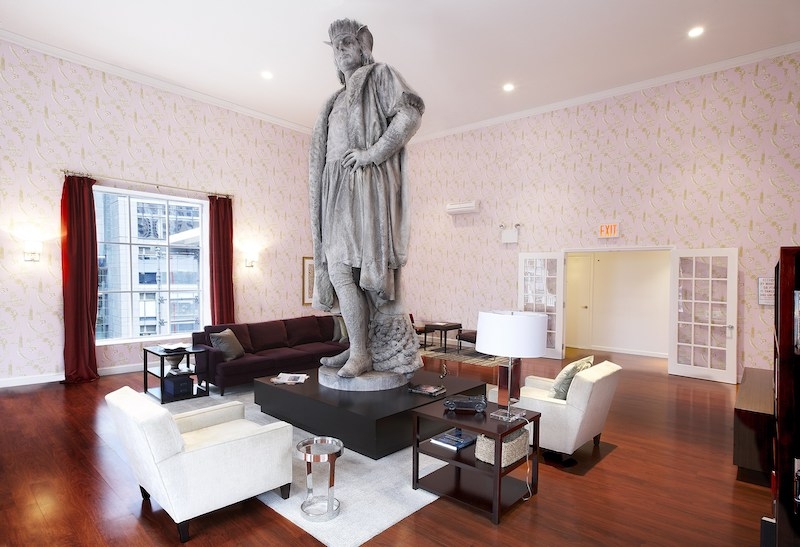
Discovering Columbus
A large-scale installation by Mr. Nishi in New York City, "Discovering Columbus". Building a living room around the statue of Columbus, he stunned and gave people a new, different view by his bold idea. About 100,000 people in total lined up to see it every day, even causing admission limit.
Moved by the approach in Colombia to use art for revival of a city
I have a story about a city and art that moved me deeply. There is a city called Medellin in Colombia, where the murder rate was the highest in the world in the 80s and 90s. In 1993, the boss of the drug-trafficking organization called Medellin Cartel got killed and the security situation got better after that, but still you see situations you cannot imagine in Japan, like people living in the pipes by the roadside or elementary to middle school aged girls standing on the street as prostitutes.
The approach the city of Medellin took to turn the city around was "revive the city by art". They started to hold free concerts in the parks and made the entrance fee for the museums free for the devastated people.
Fernando Botero, a world-famous sculptor is from Medellin and has been donating a lot of his works to the city, hoping to contribute to the revival of his hometown. Not just one or two, but a lot of them. Some are as big as 5 meters high and probably worth several million dollars and they are everywhere in the city. I was really moved by the generosity of Botero, the art approach for the city's revival, and the fact that the plan is actually starting to work. If I am asked my favorite city in the world, I always say Medellin, because I really love this city.

Fernando Botero
A sculptor born in Colombia in 1932. After studying in Madrid, Spain, he learned the fresco technique in Italy. Then he moved to the U.S. as a painter and got famous with a painting of a plump Mona Lisa "Mona Lisa at the age of 12". He then moved to Paris where he also started working as sculptor and got known for the unique works of plump humans and animals.
Free and fun art revitalize and fertilize the city
I wish municipal government in Tokyo will be like "Let's set Tokyo alight with art!" and budget for triennials and festivals. It shouldn't be that difficult. Most Japanese politicians are in their 60s and 70s, right? I have a great interest in Japan's future recently and I wonder why they wouldn't support young people who will be contributing to Japan paying tax.
Showing good artworks will expand people's imagination and it will enable people to think flexibly freed from regulations. That way, even supposedly the world's most strict Japanese regulations will be liberalized gradually. Having gone around the world, I strongly felt that Japan is the country that needs art the most. Since art destroys old values and generates new sense of values, I can say that that is exactly what Japan needs the most right now.
Editor's thoughts
Our editorial staff were completely fascinated by the powerful and frank character of Mr. Tatzu Nishi during the interview. The photos were taken at his own installation, "Capsule Hotel 21," at 21_21 DESIGN SIGHT. Actually, some of our staff participated in an event you could stay in this installation, and there was a scene where the interviewee, Mr. Nishi, interviewed us, the interviewer, about what we thought of the installation! There will be more events to come, please check the 21_21 DESIGN SIGHT homepage.
(edit_akiko miyaura)
【information】
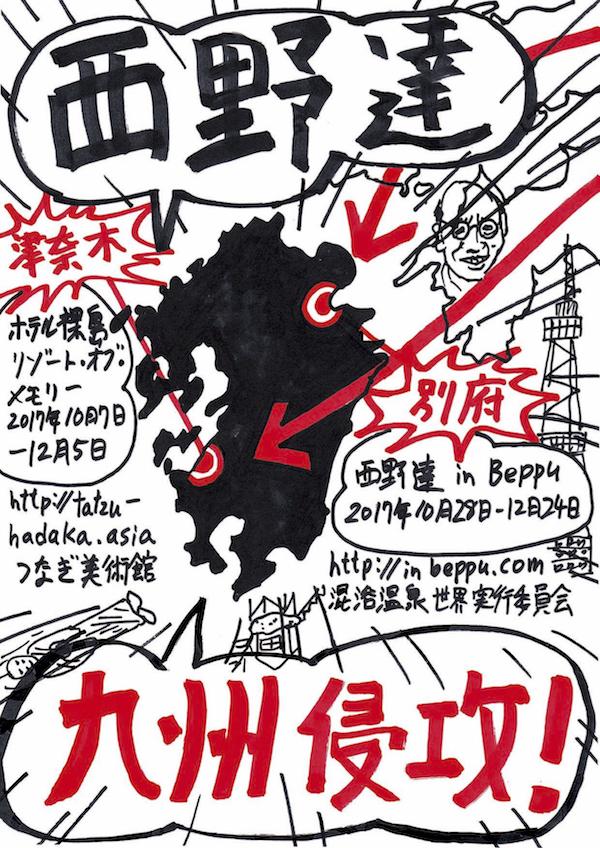
Tatzu Nishi Hotel Hadakajima Resort of Memory
Date:7 October - 5 December 2017
Place:Tsunagi town(around old Akasaki Elementary School, around Tsunagi Town Hall)
Telephone:Tsunagi Art Museum 0996-61-2222
Official Website:http://tatzu-hadaka.asia
Tatzu Nishi in BEPPU
Date:28 October - 24 December 2017
Place:Several Places in Beppu City
Telephone:BEPPU PROJECT(NPO) 0997-22-356
「in BEPPU」Website:http://inbeppu.com/




